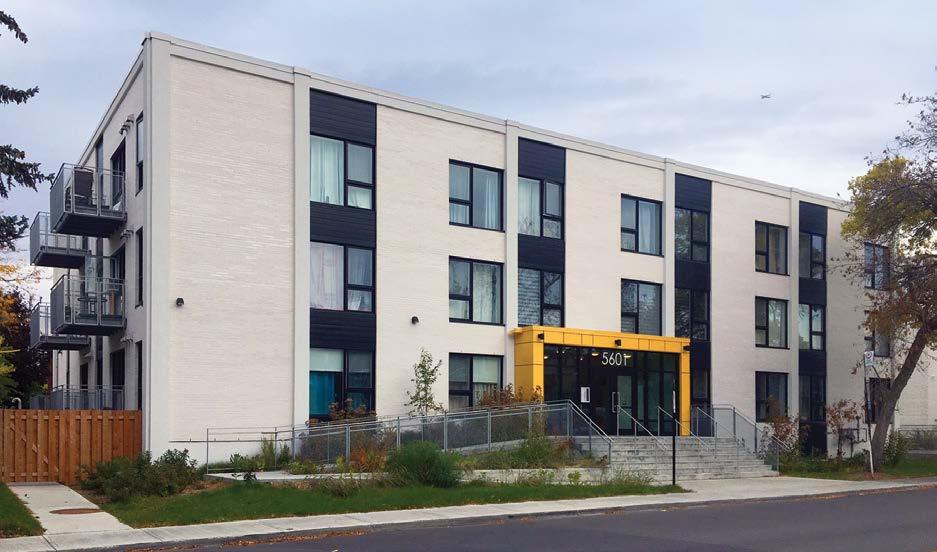
2 minute read
Innovations in Glass
Types range from bird-friendly to wired and vacuum-insulated.
By Amy Roberts
Several innovations in the glass industry are adding value to new buildings and retrofits alike, through novel and improved technologies. Glass types continue to evolve, including vacuum insulated glass (VIG), bird-friendly glass and safety glazing. Such innovations can improve sustainability, energy efficiency and injury mitigation.
Vig
With this type, a strong vacuum exists between two plates of glass. The gas space slows down conduction, while the vacuum space itself cuts back on it even further.
Bill Davis, a senior insulated glass (IG) technical service and product manager with Vitro Architectural Glass, spoke about VIG at a panel during the Fenestration and Glazing Industry Alliance (FGIA) 2022 Fall Conference. He pointed out it is very customizable, which can lead to more benefits in terms of higher R-values, indicating better thermal resistance.
“When you get into dual IGUs,” he said, “you can add coatings or an exotic gas to improve performance. Triple panes can get you even better performance—up to R-16.”
Fellow panelist Dave Cooper, chief technology officer (CTO) for VaccuumGlass, emphasized the importance of removing barriers for low-cost manufactur- ing, tempered VIGs and make-to-order supply strategies to better enable a significant market opportunity and adoption. He pointed to retrofits, new commercial construction, new residential windows, ultra-high-end residential replacements, renovations of historic structures and skylights that could all be well-served by VIG.
Bird-safe design can help building owners avoid legal exposure.
“With daylighting, we can stop thinking about window-to-wall ratio when we start thinking about VIG,” Cooper said. “VIG supports a greater window-to-wall ratio with significantly enhanced thermal performance.”
However, VIG is not without its challenges. For one thing, despite growing interest and investment, there is still no cost-effective option. Manufacturers may still be conducting today’s research and development (R&D) for tomorrow’s anticipated policies.
Bird-friendly glass
There are provincial and federal laws in Canada to protect birds. Bird-safe design can help building owners avoid legal exposure, whether their structure was originally intended to be bird-friendly or was retrofitted later.
A bird-friendly design reduces the amount of glazed surfaces in a building’s envelope, thus reducing the risk of a bird attempting to fly through it. Considerations like high-thread features, such as clear glass walkways, are also taken into account, as are lighting and opaque features, like grilles or shutters, to deter birds.
Another option is to treat glass with a subtle pattern that is perceptible to birds. Multiple suppliers offer a ‘bird-friendly glass’ featuring patterns of lines or dots.
CSA A460:19, Bird-friendly building design, addresses such visual elements as acid etchings, ultraviolet (UV) markers, fritted glass, film or non-film adhesive markers. They are designed to be in high contrast to the glazing material.
According to BirdSafe, an organization led by Fatal Light Awareness Program (FLAP) Canada, there are many other benefits to embracing bird-safe architecture, such as incorporating green building best practices and meeting sustainability goals.
The federal government recently announced the certification of 14 new bird-friendly cities in British Columbia, Alberta, Saskatchewan, Ontario, Quebec and Nova Scotia, based on a certification standard developed by Nature Canada. They join Vancouver, Calgary, London, Ont., and Toronto, which were the first cities to be certified, in 2021. The certification encourages municipalities to protect birds from human-caused threats, including but not limited to windows.

Safety glazing

First introduced some 130 years ago, wired glass represented the first attempt at developing ‘safety glass.’ It involved embedding steel wire mesh into annealed glass, while the glass was still soft during processing.
However, while wired glass may appear strong, it typically has only about half the strength of regular plate glass. The wire is a weak link in the glass, such that it may be broken more easily when impacted.


In the mid-1970s, most North American codes and/or standards granted wired glass











